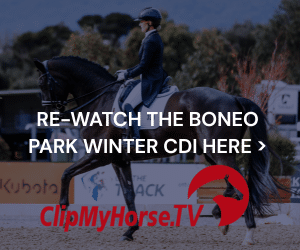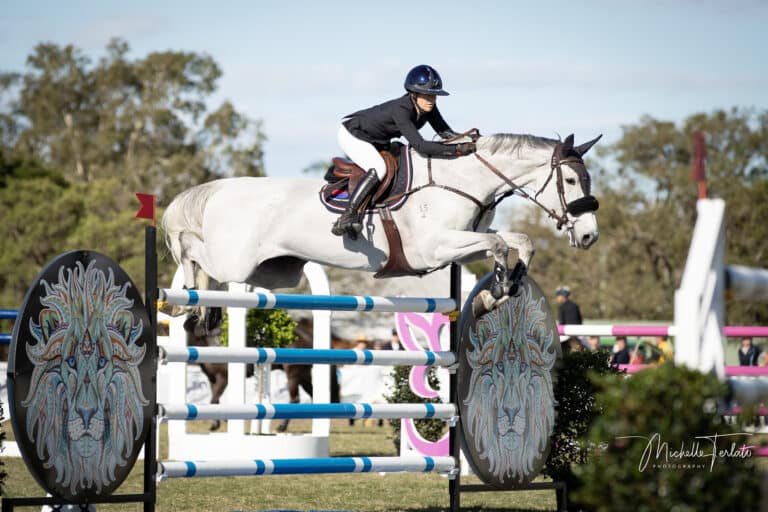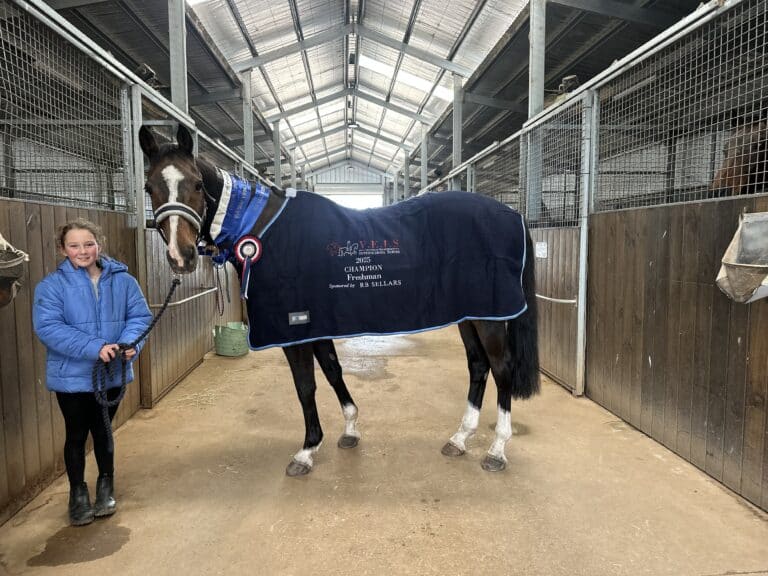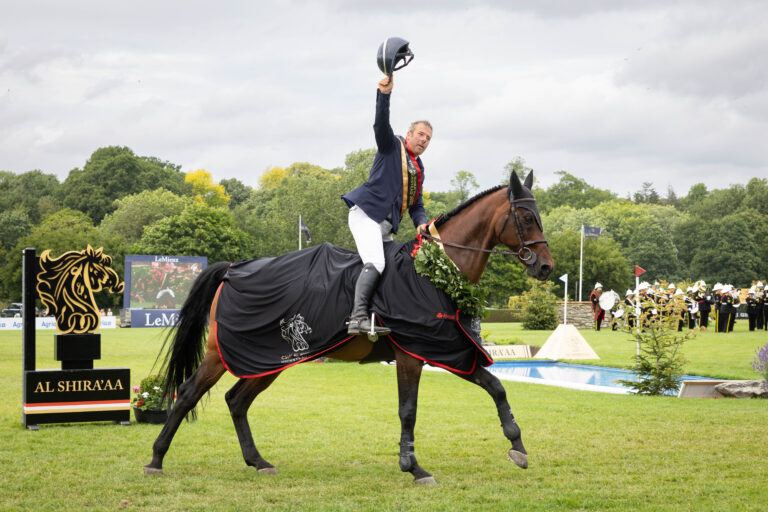This article has appeared previously with Equestrian Life. To see what is in our latest issue, please click here.

Jeff Bloomfield in action.
© Derek O’Leary
Showjump Training – part 1
with Gillie Böckmann
Gilbert Böckmann has had a number of international jumping horses such as Cordalme, Quattro and super horse HGF Can Fly. As a coach he is in demand for training by many riders from the USA, Italy, Mexico and Germany and he has a passion for developing the young riders who are the future.
The Böckmann family is involved in a variety of businesses including truck and float manufacture, a large stallion station and stud for dressage and showjumping plus the competition barns with about 50 horses in work.
The first clinic was held at Treehaven Equestrian Club on the Mornington Peninsula. Amy Graham and Kristy Bruhn travelled from SA with their Jumping Development Squad horses. Elite Squad riders Jamie Kermond, Laurie Lever and Gavin Chester (horseless due to spelling Warlord 11 before Las Vegas) were joined by Development Squad member Rebecca Allen. The remaining spaces were offered by the EFA Victorian SJ committee to state squad members that could attend the three days. David and Lind Dobson were flown over by the EFA without horses to be part of the process.
Gillie’s innate ability to be able to work with all riders on their positions and individual horse issues was evident. Three core components in the training sessions included working on the riders’ positions, focus on individual horse issues and developing knowledge around the training exercises.
The first day concentrated on jumping flatwork, developing suppleness, roundness, evenness of stride and rhythm. Changes in circle sizes and tempo occurred with the focus on maintaining direct contact in order for the horses to be able to improve their adjustability. Focus on the circle was to maintain control over the hindquarters – particularly the outside hind. All the exercises developed from one to the next to add more degree of difficulty and the importance of being able to travel in the right frame, tempo, balance and in control.
Horses started each training session working on the basics with the building blocks being developed to the necessary level, i.e. the World Cup horses started with the basics and built up to their level and the young horses built to their comfort zones. The main issue for Australians is that they have difficulty keeping the horse between the hand and the leg on, riders can keep horses on the hand or the leg but not between on a more consistent basis and this is an issue that we need to address.
The jumping exercises were designed in such a way that the horses could develop their balance and jump without too much interference from the riders. As Gillie emphasised, ‘While training over low fences and doing the exercises, try not to regulate the horse’s strides, allow the jumps and poles set up to do this. It is important not to ruin, right from the beginning, the horse’s initiative. It is important for the horse to learn to assess the situation and cope with it. It is your job to assist the horse in making a straight steady approach to the fence, allow the horse to do the exercise with you in the best position possible, and then it is your job to control the ride post jumping. Concentrate on the whole exercise from the beginning, through the exercise and all the way back to walk, think about your position and the effect you as a rider are having influencing the correctness of training.’ When the exercises were not performed as required it was a ‘no problem’ attitude with Gillie. The exercise was simply repeated until the horse and rider got it right – no fuss and no pressure.
Here are a few exercises to start with.
Exercise one


Exercise One – Ally Lamb with young horse
Trot poles spaced for a good trot through them (5 poles today) and then shorten the distance in between the poles in order for the horses to be more collected in trot and to bend their knees.
‘The more experienced the horses are the closer distance you can set the poles’, Gillie stated, ‘You want the horses to be able to stretch over the poles and bend their knees and hocks and to look where they are putting their feet. When you shorten the distance between the poles it assists them in bending their hocks and developing greater lift – so in this way they must exercise to stretch and strengthen muscles in basic training.’
Exercise two

Exercise Two – Leonie McAteer with B Grade horse

This is a curved line approach so the rider must still make sure that they can control the line to have the horse in the middle of the jump. This is where it is important to be able to ride and have control over both sides of the horse to stop them dropping in or bulging out on approach and throughout the exercise. You can use the 20 metre or 10 metre circle to assist in maintaining tempo. Control is with your legs and seat – inside leg to outside hand.
Gillie concentrated here on the rider’s position, ‘Try not to get in front of the horse over the trot poles and do not go forward until the horse jumps. Maintain control over the hindquarters particularly the outside hind.’ This exercise can be done in trot and canter so the distances between the poles will need to be changed. For trot make the distance in the middle of the pole 1 metre apart and in cantering 2 metres on the inside and 3 metres on the outside of the arc.
Exercise can be done in trot and canter.
Exercise three

Exercise Three – David Lever with D Grade horse

Exercise four
One Trot circles over poles on the outer circle and then the inner circle, change direction and then repeat. One side of the rail can then be placed on a cup on each of the wings at 50 cms or 60 cms.

Two Canter the same sequence with focus being on the canter stride in between the rails. The inner circle will require a more collected canter and the outer circle will require more forward riding. You can mix up the exercise by riding on the inner line and then take the outer line. It is all about keeping a balanced canter in between the rails.
Three Attempt striding variations, which will entail the rider being able to adjust the canter stride, i.e. try to ride 3 strides between the poles, then 4, then 5 strides to see if you can make the adjustment. The rider’s position is important here so keep your body steady, hands down and do not get ahead of the movement with your body. The idea is to see if you can make the stride adjustment with the minimum amount of hand, leg or body adjustment being shown. ‘It is your job to improve your riding so that adjustments can be made with minimal interference by you. A slight movement in your upper body or shift in your hip or transference of weight should improve with training so that the horse is very responsive to you,’ Gillie commented.
Four If you have a horse that is hot by nature and is getting into difficulties just use 1 and 3 going around the outside of 2 and 4.

It is your job to improve your riding.

Exercise Four – Amy Graham riding Transatlantic

The development of flatwork must be kept in relation to the level of the jumping. As the degree of difficulty increases as you progress through the grades and the technicalities on course creep in, then the rideability is often what shifts the winning pendulum to the better trained horses. This may be one reason why Australia has so many horses that don’t progress up the grades.
READ THE LATEST NEWS ARTICLES HERE







